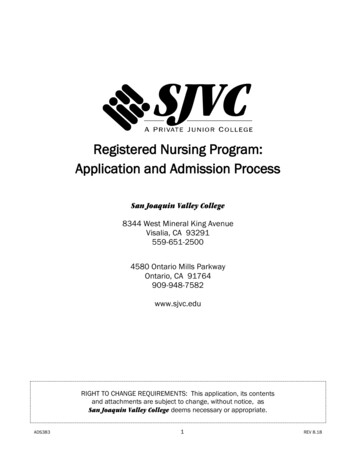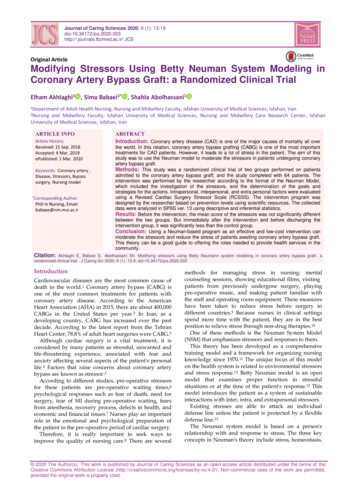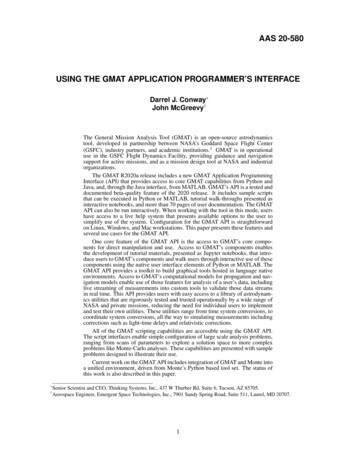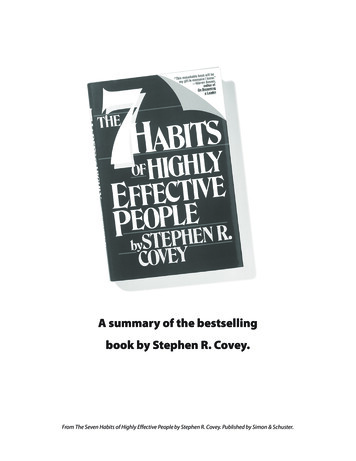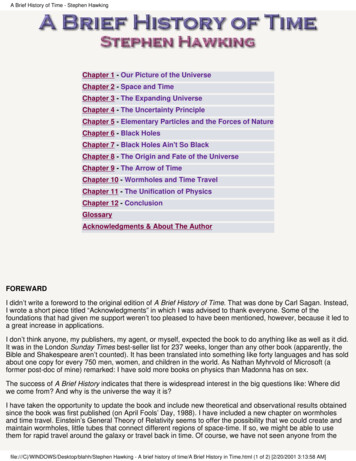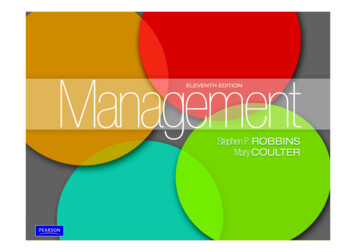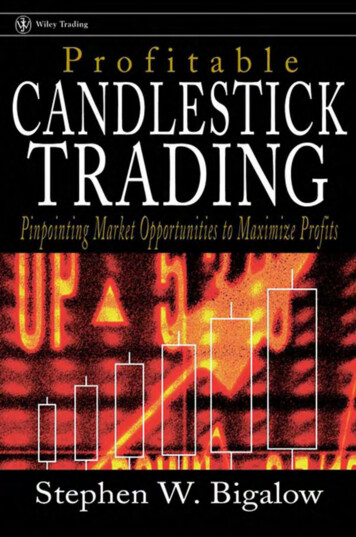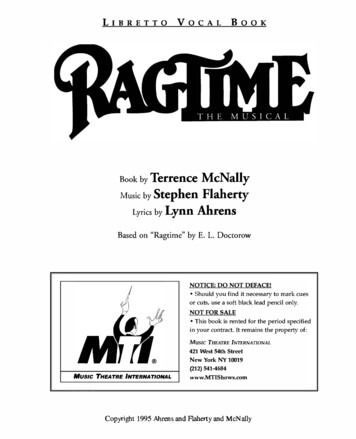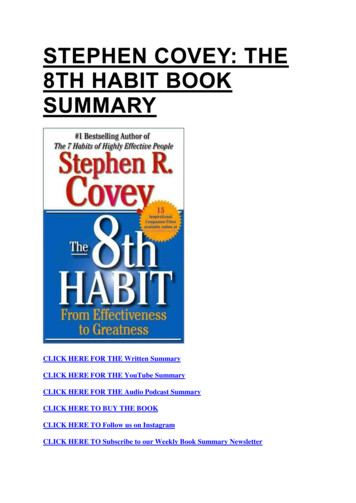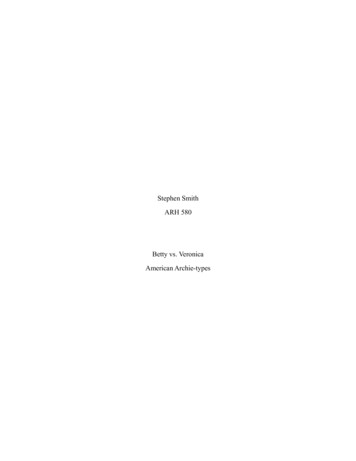
Transcription
Stephen SmithARH 580Betty vs. VeronicaAmerican Archie-types
1Archie’s WorldArchie Comics Publications, Inc.introduced its first openly gay characterin September 2010. The cover of Veronica #202 (fig. 1) exclaims, “meet thehot new guy.” The homosexual KevinKeller enters a world that is nothing ifnot wholesome, middle American, anduncontroversial. The mainstream pressresponded to Kevin as little more thananother human interest or business story.1 The gay press applauded the move2but, in general, the lack of outrage andcriticism by the usual suspects3 is a clearsign of the social progress of Americanculture. The character of Archie An-1.drews is designed to be the most “average” of all possible American teenagers. He livesin the average town of Riverdale and attends the unremarkable Riverdale High. He is notparticularly wealthy or poor, intelligent of dumb, athletic or nerdy, large or small. He is theabsolute center of the bell curve of the American teenage boy. The main female characters,Betty Cooper and Veronica Lodge, along with Archie, form a love triangle that has goneunresolved for almost seventy years. These characters have represented the “norm” as the“norm,” itself, has dramatically changed. What effect do Archie, Veronica, and Betty haveon the establishment of gender identities among their readers? How have Archie comicsevolved as American society, as a whole, has become more inclusive? It is fair to say that the1. The Associated Press, “Archie Comics Unveils Gay Character,” New York: The AssociatePress, (April 27, 2010).2. David Rogers, “Archie’s Closet,” Cue Pittsburg (July, 2010): 26.3. Nina Kester, Archie Publications, Inc., telephone contact, November, 29, 2010.
2publishers, writers, and artists at Archie comics have made an admirable effort to be sociallyresponsible with regards to these issues. The creators of the unique cast of characters thatpopulate Riverdale have attempted to reflect the tremendous social changes that have takenplace in real-life cities and have constantly done so with humor and a nonchalant acceptance.Red-Headed, All-American BoyWho should be given credit for the creation of the Archie characters is a matter ofdispute. What is not in dispute is that, with few exceptions, the artists and writers have beenmen. The often repeated story of Archie’s origin is that just as America was entering theSecond World War, John Goldwater, a publisher of superhero comics went to his art department and asked who could come up with a new kind of character. Goldwater was lookingfor a sort of everyman, or rather everyboy,type like the one portrayed by MickeyRooney in the wildly popular Andy Hardyseries. A very young, and extremely talented Bob Montana (1920-1975) rose to theoccasion. In 1996 Montana’s estate fileda lawsuit against Archie Comics Publications to settle who exactly should be givencredit for the character’s origins. The decision, and its undisclosed terms, resultedin Goldwater being named “creator” andMontana “creator of the original character’s likenesses.”4 Regardless of the legal2.decision the artist, rather than the publisher, is generally considered the father of the brandby comic book collectors and fans who, in fan publications and on the internet, still universally give Montana credit for creating Archie and the gang.4. Jim Windolf, “American Idol” Vanity Fair, vanityfair.com (December 20, 006/12/archie200612.
3Once Upon a Time in RiverdaleArchie Andrews made his debut in a comic book titled Pep #22 (fig. 2) in December 1941. Soon after the debut Joe Montana was drafted into the Army, but his characterswould immediately grab the public’s imagination. Archie quickly expanded into a numberof comic book titles and was soon followed by a weekly radio program and eventually anumber of television series and every sort of merchandising product. In the mid-1950s thepublishing company that produced Pep, MLJ Magazines, would officially change its nameto Archie Comics Publications, Inc. to reflect the success of their most popular character.Today the company is the only family-owned and independent publisher in the industry.5Though in decline, Archie Comics still maintains a healthy circulation of roughly half amillion comic books a month6 in addition to a newsstand magazine called Life with Archiethat began publishing in August 2010. Comic books, in general, are only a shadow of theirformer selves. “In the mid-1940s the comic book was the most popular form of entertainment in America. Comics were selling between eighty million and a hundred millioncopies every week.By 1952 more than twenty publishers were producing more than 650comic titles per month.”7 The fictional rock band spawned from one of the Archie cartoonseries even managed to create a pop hit, Sugar, Sugar, in 1969 that made it to the top of thecharts in the United States, England, and Canada. Sugar Sugar was written by Jeff Barryand Andy Kim would be covered the following year by Bob Marley and the Wailers.MethodologyWithout venturing too far from the strict confines of the analytic tradition how canone explore the presuppositions of feminist and queer theory? “Because gender roles donot easily translate into an observable set of behaviors, studying the media’s influence on5. Tina Gant, International Directory of Company Histories, Vol. 63 (Farmington Hills, Michigan:St. James Press, 2004), 6. These figures are based on publicly available publisher’s 9/archie-sales-figures-for-2009/.7. David Hajdu, The Ten-Cent Plague: The Great Comic Book Scare and How it Changed America(New York:Farrar, Straus and Giroux, 2008), 5.
4gender-related behavior is difficult.”8 Postmodernism and more specifically “[d]econstruction is antiessentialist not only in viewing the search for universal definitions as useless, butalso in actively challenging the traditional boundaries between oppositions such as reason/emotion, beautiful/ugly, and self/other as well as between disciplines such as art, science,psychology, and biology.”9 If, as Michel Foucault, Judith Butler and others have taught us,gender roles are the result of power relations and ultimately social constructs, who is doingthis construction? It is fair to say that, in America, some indeterminate percentage of thisgender creation must fall in the laps of the of the creators of Archie comics. Though Bettyand Veronica are far from admirable role models, they are also far from objectified victims.They are average. It can be argued that they are average in the sense that they have helpeddefine the status quo. “The concept of teenagers was still pretty new when Archie camealong.”10 One can safely assume that the idea of the American teenager has been shapedby, but has also contributed to, the creation of popular culture. As technology has increasedit has become possible for ever smaller groups to affect larger and larger portions of thepopulation. Certainly the ever increasing feedback loop between the speed of productionand reproduction and customer demand has allowed Americans, and American teenagers inparticular, a level of control over their consumer culture that would have been impossiblein earlier times. The soft science of advertising and marketing seems to always follow anincreasingly empowered audience whose consumption dictates which products will succeed and which will fail.Pals and GalsAmong Archie’s “pals and gals” we find a cast of teens that are stereotypical but farfrom two-dimensional. The overconfident and egomaniacal Reggie Mantel is both Archie’s fast8. Monique Ward and Kristen Harrison,“The Impact of Media Use on Girl’s Beliefs about GenderRoles, Their Bodies, and Sexual Relationships: A Research Synthesis,” in Featuring Females: FeministAnalyses of Media (Washington, DC: American Psychological Association, 2005), 7.9. Rosemarie Tong, Feminist Thought: A Comprehensive Introduction (Boulder, Colorado: Westview Press, 1989), 219.10. Trina Robbins, From Girls to Grrrlz: A History of Comics From Teen to Zines (San Francisco:Chronicle Books, 1999), 11.
5friend and primary foe. The two are locked in an eternal struggle for the affections of, alternately, Betty or Veronica. Yet often they will double date or change partners from one storylineto the next. Archie’s constant and devoted, best friend is the woman-hating, gluttonous JugheadJones. When rumors began circulating about the introduction of a homosexual character intoRiverdale, the often-heard joke in the gay community was, “it must be Jughead.”11 As fashionschanged over the years Archie lost his bow-tie but Jughead’s crown has remained. This particular headgear is the remnant of a short-lived fad in the early 40s when a boys would take theirfather’s old fedoras and cut them into individual and unique shapes. When the company triedto update Jughead’s look with a backwards baseball caps fans of the comic revolted.12 ThoughJughead professes no sexual interest in the female gender, there is one girl that has always hadher eyes on him. The awkwardly tall, buck-toothed Big Ethel Muggs has historically been drawnin an exaggeratedly homely fashion, but as the franchise has become more sensitive to its role inidentity building, Ethel has had a dramatic makeover. She now appears rather cute (fig. 3). The11. Rogers, op. cit., 26.12. Kester, op. cit.3.
6impossibly smart Dilton Doiley’s inventions and Veronica’simmensely wealthy father, Hiram Lodge, are classic comicstrip types that are used as vehicles for any number of adventures. In the late 90s Archie comics introduced a plus-sizedgirl to Riverdale, Brigitte Reilly (fig. 4). The hulking bully,Big Moose, long considered dumb, has now been diagnosedwith dyslexia.13Though quintessentially American, Archie readership is all over the globe. In Spanish speaking counties heis known as Archi Gómez, and there are even Japanesestyle manga versions of the Archie characters. Flippingthrough almost any Archie comic today one finds thatAfrican-American characters are ubiquitous. Archie hasan Asian-American friend named Tomoko Yoshida anda Puerto Rican pal, Frankie Valdez. There are also twoHispanic girls in Archie’s universe, Maria Rodriquez andGinger Lopez. The Indian-American Raj Patel is often4.grating on the other character’s nerves because of his obnoxious obsession with filmmaking (fig. 5). These non-Caucasian characters are far from “token” or milquetoast.5.13. Ibid.
7Art SmartAmerican comic strips have historically worked within a constructedlanguage of signs and symbols. The wordballoon is incorporated into the artwork asa graphic element. Emotion is illustratedby exaggerated gesticulation and facialexpressions along with creative executionof the dialogue and lettering. Motion andemotion are expressed by lines radiatingBob Montanafrom the figures. This is a specific language that has been developing in earnest throughtrial and error over the course of the past century. Even as comic strips have become moreindividualized, certain fundamentals have remained constant. The dialogue is almost exclusively executed in all capitals and virtually every sentence ends with an exclamation point.The old, tedious method of cutting and angling screens to produce color was replaced bycomputers in the 80s but hand lettering is still a major part of the aesthetic of many comicstrips, including the Archie line.14 Most comic artists work with a brush and ink that owesBob Montana14. Ibid.
8as much to eastern as western tradition. Though usually handled with a mastery that disguises the difficulty, anyone who has tried to create the confident line work common inArchie comics should appreciate the skill of its many artists. Today there averages aroundfifty free-lance artists working at any given time on the various Archie titles.15For a comic strip whose primary readership is pre-teen girls, it might seem odd thatalmost all the artists that have drawn Archie comics have been men. This is arguably due tothe recruitment of talent from historically male-dominated institutions like the Joe KubertSchool of Cartoon and Graphic Art16 and the fact that these artists might also work for othercomic lines aimed at boys. Besides Bob Montana some of the most celebrated and giftedof these artists have been Al Hartley (1921-2003) and Dan DeCarlo (1919-2001). One ofHartley’s most significant contributions to the Archie universe has been the Spire groupof Christian comics. Besides producing comic strip adaptations of popular Christian titlessuch as The Cross and the Switchblade and God’s Smuggler, Hartley also created a number of Christian titles featuring the Archie characters. In the Spire series Betty is presentedas the most pious and Bible-believing of the characters and is thus the object of Archie’saffection rather than the self-centered Veronica. The Archie Christian comics were published in the early 70s before that religion began its continued move to the political right inAmerica. Archie and Betty pray to a non-materialistic Jesus concerned with love yet silentabout abortion and homosexuality. In one Spire title, Archie’s Something Else, a cynicaltelevision crew comes to Riverdale High looking for the “drug problem,” “occult activity,”and “sex education.” They demand that Principle Weatherbee show them some “perverts”and “radicals.” When the crew sees Betty with her head bowed they assume she had beenworked too hard by the “oppressive system” and are shocked to find out she is praying.Hoping to find some racial discrimination they are led to a meeting of the Riverdale BibleClub where a smiling African-American teen with a large Afro hairstyle informs them that15. Ibid.16. Ibid.
9racial differences were “settled 2000 yearsago.”Unlike Al Hartley, it is unlikely thatDan DeCarlo would view what
Though in decline, Archie Comics still maintains a healthy circulation of roughly half a million comic books a month6 in addition to a newsstand magazine called Life with Archie that began publishing in August 2010. Comic books, in general, are only a shadow of their former selves. “In the mid-1940s the comic book was the most popular form of enter- tainment in America. Comics were selling .
